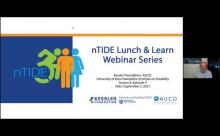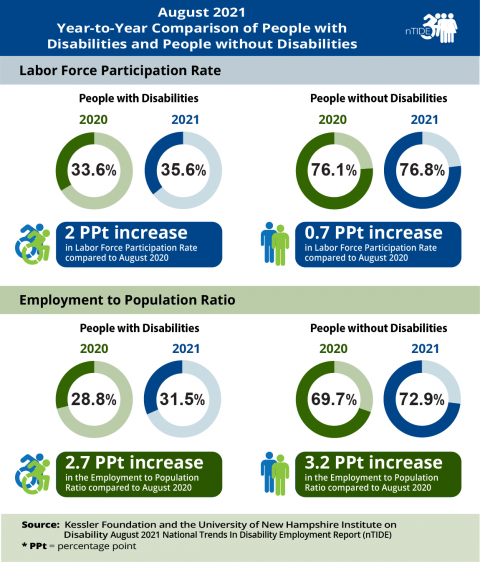
Economic indicators flattened following the sharp rises seen in June, with minor declines for people with disabilities and slight increases for people without disabilities, according to today’s nTIDE. Guest presenter Samantha Evans of the International Association of Accessibility Professionals (IAAP), a division of G3ict, where she works with accessibility subject matter experts and professionals around the world to maintain, build, and deliver accessibility certification programs.
Economic indicators flattened following the sharp rises seen in June, with minor declines for people with disabilities and slight increases for people without disabilities, according to today’s nTIDE. Guest presenter Samantha Evans of the International Association of Accessibility Professionals (IAAP), a division of G3ict, where she works with accessibility subject matter experts and professionals around the world to maintain, build, and deliver accessibility certification programs.
nTIDE August 2021 Jobs Report: Employment slows as COVID pandemic restrictions loom
National Trends in Disability Employment (nTIDE) – issued semi-monthly by Kessler Foundation and the University of New Hampshire
Durham, NH – September 3, 2021 – Economic indicators flattened following the sharp rises seen in June, with minor declines for people with disabilities and slight increases for people without disabilities, according to today’s National Trends in Disability Employment – Monthly Update (nTIDE), issued by Kessler Foundation and the University of New Hampshire’s Institute on Disability (UNH-IOD). If the spread of the COVID-19 Delta variant causes the reinstatement of restrictions on business activity, a chilling effect is likely on upcoming job numbers.
nTIDE COVID Update (month-to-month comparison)

In the Bureau of Labor Statistics (BLS) Jobs Report released Friday, the employment-to-population ratio for working-age people with disabilities increased from 30.8 percent in July to 31.5 percent in August 2021 (up 2.3 percent or 0.7 percentage points). For working-age people without disabilities, the employment-to-population ratio decreased slightly from 73.4 percent in July to 72.9 percent in August 2021 (down 0.7 percent or 0.5 percentage points). The employment-to-population ratio, a key indicator, reflects the percentage of people who are working relative to the total population (the number of people working divided by the number of people in the total population multiplied by 100).
“[switch front end and add striving]The minor decline in the employment-to-population ratio for those with disabilities that we saw in July was somewhat reversed in August,” said John O’Neill, PhD, director of the Center for Employment and Disability Research at Kessler Foundation. “This upward movement may be related to greater numbers of people becoming vaccinated and people with disabilities feeling safer returning to the labor market,” he added.
The labor force participation rate for working-age people with disabilities increased from 35.2 percent in July to 35.6 percent in August 2021 (up 1.1 percent or 0.4 percentage points). For working-age people without disabilities, the labor force participation rate also decreased from 77.6 percent in July to 76.8 percent in August 2021 (down 1.0 percent or 0.8 percentage points). The labor force participation rate is the percentage of the population that is working, not working and on temporary layoff, or not working and actively looking for work.
“Throughout Pandemic, people with disabilities have demonstrated a tremendous deal of resilience as evident in their labor force participation of people with disabilities has remained strong and continuing to increase,” said Andrew Houtenville, PhD, professor of economics and the research director of the University of New Hampshire’s Institute on Disability. “We expect people with disabilities to remain in the labor force (working, looking for work, or on furlough), even as the Delta variant spreads and if many social distancing requirements are reinstated,” he added.
Year-to-Year nTIDE Numbers (comparison to the same time last year)

The employment-to-population ratio for working-age people with disabilities increased from 28.8 percent in August 2020 to 31.5 percent in August 2021 (up 9.4 percent or 2.7 percentage points). For working-age people without disabilities, the employment-to-population ratio also increased from 69.7 percent in August 2020 to 72.9 percent in August 2021 (up 4.6 percent or 3.2 percentage points).
The labor force participation rate for working-age people with disabilities increased from 33.6 percent in August 2020 to 35.6 percent in August 2021 (up 6 percent or 2 percentage points). For working-age people without disabilities, the labor force participation rate also increased from 76.1 percent in August 2020 to 76.8 percent in August 2021 (up 0.9 percent or 0.7 percentage points).
In August 2021, among workers ages 16-64, the 4,932,000 workers with disabilities represented 3.4 percent of the total 143,071,000 workers in the U.S.
Ask Questions about Disability and Employment
Join our nTIDE Lunch & Learn series today, September 3, at 12:00 pm Eastern. This live broadcast, hosted via Zoom Webinar, offers attendees Q&A on the latest nTIDE findings, provides news and updates from the field, as well as invited panelists to discuss current disability-related findings and events. Today, Samantha Evans of International Association of Accessibility Professionals, joins Drs. Houtenville and O’Neill, and Denise Rozell, Policy Strategist at AUCD. Join live or watch the recordings at: ResearchonDisability.org/nTIDE.
nTIDE COVID Update – Friday, September 24 at 12:00 pm Eastern
Stay tuned for our mid-month update about the employment of people with disabilities as we follow the impact of COVID-19 and look at the numbers in more detail.
